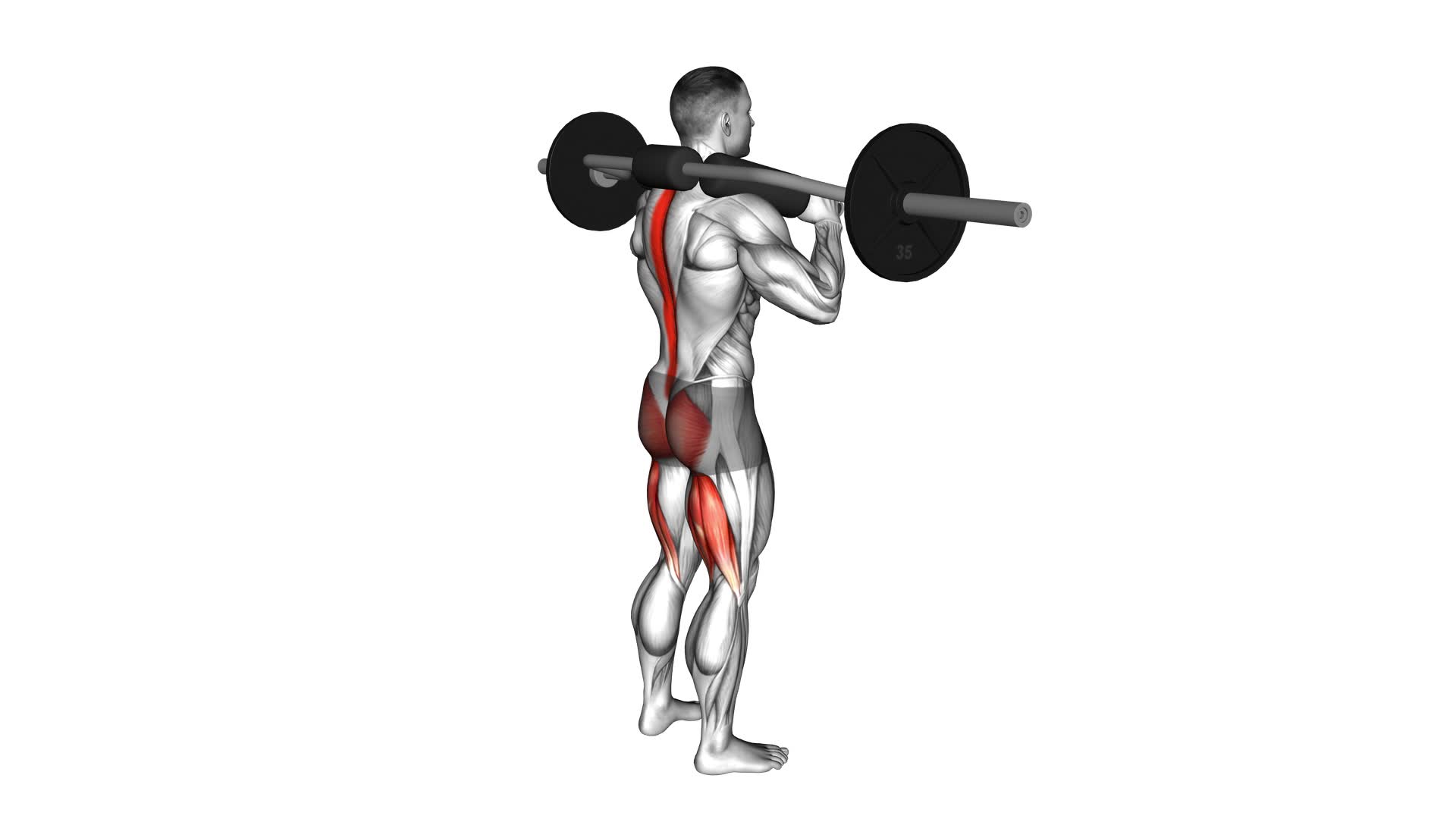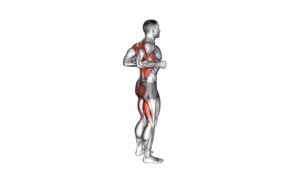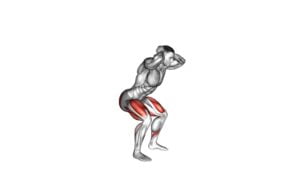Safety Bar Good Morning (male) – Video Exercise Guide & Tips

Are you looking for a new exercise to add to your routine? Look no further than the Safety Bar Good Morning!
Watch This Exercise Video
This video exercise guide and tips article will show you the proper form and technique for men. Whether you're a beginner or advanced fitness enthusiast, we've got modifications and progressions for all fitness levels.
Plus, we'll provide safety tips to ensure a successful workout. Get ready to strengthen your lower back and hamstrings with this effective exercise.
Let's get started!
Key Takeaways
- Safety Bar Good Morning targets muscles in the lower body.
- Safety Bar Good Morning improves overall strength and stability in the targeted muscle groups.
- Safety Bar Good Morning strengthens the posterior chain for better athletic performance.
- Safety Bar Good Morning offers variations and customization options to suit specific fitness goals.
Benefits of the Safety Bar Good Morning
The safety bar good morning exercise offers multiple benefits for male athletes and fitness enthusiasts. This exercise primarily targets the muscles in the lower body, including the hamstrings, glutes, and lower back. By incorporating this exercise into your workout routine, you can improve your overall strength and stability in these muscle groups.
One of the key benefits of the safety bar good morning is its ability to strengthen the posterior chain. This refers to the muscles on the backside of your body, including the hamstrings, glutes, and lower back. By strengthening these muscles, you can improve your athletic performance in activities such as running, jumping, and squatting.
Additionally, the safety bar good morning exercise offers variations that allow you to target specific muscle groups. For example, by adjusting the position of your feet or the angle of your torso, you can place more emphasis on either your hamstrings or your glutes. This versatility allows you to customize the exercise to suit your specific fitness goals.
Equipment and Set-up for the Exercise
To properly perform the safety bar good morning exercise, you'll need specific equipment and set-up. Here are the essential items and steps to ensure a successful workout:
Equipment:
- Safety bar: This specialized barbell is designed with handles on the sides and a pad to rest on your shoulders. It provides stability and minimizes strain on your lower back during the exercise.
- Weight plates: Choose the appropriate weight plates based on your fitness level and goals. Start with lighter weights and gradually increase as you progress.
Set-up:
- Position the safety bar: Place the safety bar on a squat rack at a height that allows you to comfortably reach it with your hands.
- Load the weight plates: Add weight plates to both sides of the bar, making sure they're secured tightly.
- Adjust the pad: Position the pad on the bar to rest comfortably on your shoulders. Ensure that it's centered and secure.
Proper Form and Technique for Men
To perform the safety bar good morning exercise with proper form and technique, focus on maintaining a neutral spine and engaging your core muscles throughout the movement. This exercise is a great addition to any men's fitness routine, as it targets the lower back, glutes, and hamstrings.
Start by positioning the safety bar on your upper back, just below your neck, and make sure it's securely in place. Stand with your feet shoulder-width apart and your toes slightly turned out. Bend at the hips, pushing them backward while keeping your chest lifted and your back straight. Lower your upper body until it's parallel to the floor, feeling a stretch in your hamstrings.
Remember to keep your core engaged and your spine neutral throughout the exercise. To return to the starting position, squeeze your glutes and push your hips forward. This movement should be controlled and deliberate, focusing on the muscles being targeted.
By maintaining proper form and technique, you can maximize the benefits of this exercise and minimize the risk of injury.
Now, let's move on to the next section to learn about common mistakes to avoid.
Common Mistakes to Avoid
When performing the safety bar good morning exercise, be cautious of these common mistakes to ensure proper form and technique:
- Using too much weight: One of the most common mistakes is using a weight that's too heavy. This can put excessive strain on your lower back and increase the risk of injury. Start with a lighter weight and gradually increase as your form and strength improve.
- Rounding your back: Another mistake to avoid is rounding your back during the exercise. This can also put stress on your lower back and increase the risk of injury. Keep your back straight and your core engaged throughout the movement.
- Lifting with your arms: Many people make the mistake of using their arms to lift the weight instead of relying on their hips and glutes. This not only reduces the effectiveness of the exercise but also puts unnecessary strain on your upper body.
To prevent these common mistakes and ensure injury prevention, focus on maintaining proper form, using an appropriate weight, and engaging the correct muscles. By doing so, you can maximize the benefits of the safety bar good morning exercise while minimizing the risk of injury.
Now that you're aware of the common mistakes to avoid, let's move on to discussing modifications and progressions for all fitness levels.
Modifications and Progressions for All Fitness Levels
For modifying and progressing the safety bar good morning exercise based on your fitness level, you can start by adjusting the weight and repetitions. If you're a beginner, it's important to start with lighter weights to ensure proper form and prevent injury. As you become more comfortable and confident with the exercise, gradually increase the weight to challenge your muscles.
To further modify the exercise, you can also adjust the range of motion. If you have limited flexibility or mobility, you can start with a smaller range of motion and gradually increase it over time. This will help you gradually build strength and flexibility in your hamstrings and lower back.
For those looking to progress the exercise, you can increase the weight and repetitions as you become stronger. Adding more weight will further challenge your muscles and promote muscle growth. Additionally, increasing the repetitions can help improve muscular endurance.
Remember, it's important to listen to your body and progress at a pace that's comfortable for you. Pushing yourself too hard too soon can lead to injury. Always consult with a certified fitness professional if you have any concerns or questions about modifying or progressing the safety bar good morning exercise.
Now that you understand how to modify and progress the exercise, let's move on to some important safety tips for a successful workout.
Safety Tips for a Successful Workout
To have a successful workout and prevent injuries, it's crucial to focus on proper form. By maintaining correct form, you can effectively target the intended muscles and minimize the risk of strain or imbalance.
Remember to start with light weights and gradually increase the intensity as your strength and technique improve.
Proper Form Importance
Maintain proper form throughout your workout to ensure a safe and successful experience. Proper form is of utmost importance as it not only helps prevent injuries but also maximizes the effectiveness of your exercises.
Here are some key reasons why technique matters:
- Injury prevention: Proper form ensures that you're engaging the correct muscles and using the right alignment, reducing the risk of strains, sprains, and other injuries.
- Muscle activation: Using the correct technique targets the intended muscles, allowing for efficient muscle activation and growth.
- Postural alignment: Proper form helps maintain good posture, which is crucial for spinal health and overall body alignment.
- Balance and stability: Correct body positioning during exercises enhances balance and stability, reducing the chance of falls or accidents.
Preventing Workout-Related Injuries
When preventing workout-related injuries, it's important to prioritize safety and follow these tips for a successful workout.
First, always warm up before starting any exercise routine. This helps to increase blood flow to your muscles and prepares them for the upcoming workout.
Additionally, use proper form and technique during exercises to minimize the risk of injury. It's crucial to maintain good posture and alignment, as well as to avoid sudden movements or jerking motions.
Another key aspect of injury prevention is to listen to your body. Pay attention to any pain or discomfort and modify or stop the exercise if needed.
Lastly, don't forget to cool down and stretch after your workout to help prevent muscle soreness and promote flexibility.
Frequently Asked Questions
Can Women Also Perform the Safety Bar Good Morning Exercise?
Yes, women can definitely perform the safety bar good morning exercise. It's a great exercise for women's fitness as it targets the glutes, hamstrings, and lower back.
However, if you're looking for alternative exercises, there are other options like Romanian deadlifts or kettlebell swings that can provide similar benefits.
It's important to consult with a fitness professional to ensure proper form and technique when performing these exercises.
How Often Should the Safety Bar Good Morning Exercise Be Performed?
To get the most out of the safety bar good morning exercise, it's important to know how often to do it. The frequency of this exercise will depend on your fitness goals and overall workout routine.
For beginners, it's recommended to start with two to three times a week and gradually increase as you get more comfortable. Modifying the exercise by using lighter weights or reducing the range of motion can help beginners build strength and avoid injury.
Incorporating the safety bar good morning into your workout routine can provide numerous benefits, such as strengthening your lower back, glutes, and hamstrings.
Can the Safety Bar Good Morning Exercise Help Improve Posture?
Yes, the safety bar good morning exercise can help improve your posture.
By incorporating this exercise into your routine, you can strengthen your lower back and improve balance, which are both important factors in maintaining good posture.
This exercise targets the muscles in your lower back, hips, and glutes, helping to increase stability and alignment.
Regularly performing the safety bar good morning exercise can contribute to better overall posture and a stronger, healthier body.
Are There Any Specific Warm-Up Exercises Recommended Before Performing the Safety Bar Good Morning?
To ensure a safe and effective workout, it's important to incorporate specific warm-up exercises before performing the safety bar good morning. Warm-up exercises help prepare your muscles and joints for the intensity of the workout. They increase blood flow, improve flexibility, and reduce the risk of injury.
Some recommended warm-up exercises include:
- Light cardio activities like jogging or jumping jacks
- Dynamic stretches like arm circles and leg swings
- Mobility exercises like shoulder rolls and hip circles
Taking the time to warm up properly will greatly benefit your workout.
Can the Safety Bar Good Morning Exercise Be Done at Home or Is It Only Suitable for the Gym?
Yes, you can definitely do the safety bar good morning exercise at home. It isn't only suitable for the gym.
This exercise is great for targeting your lower back, hamstrings, and glutes. If you don't have access to a safety bar, you can try alternatives like using a barbell or dumbbells.
The benefits of doing the safety bar good morning at home include improved strength, stability, and overall lower body development.
Conclusion
In conclusion, the safety bar good morning is a highly beneficial exercise for men, offering numerous advantages such as strengthening the lower back, glutes, and hamstrings. Proper form and technique are essential to maximize results and prevent injury.
Avoiding common mistakes and gradually adding modifications and progressions can help individuals of all fitness levels improve their strength and endurance. Lastly, following safety tips will ensure a successful and productive workout.

Author
Years ago, the spark of my life’s passion ignited in my mind the moment I stepped into the local gym for the first time. The inaugural bead of perspiration, the initial endeavor, the very first surge of endorphins, and a sense of pride that washed over me post-workout marked the beginning of my deep-seated interest in strength sports, fitness, and sports nutrition. This very curiosity blossomed rapidly into a profound fascination, propelling me to earn a Master’s degree in Physical Education from the Academy of Physical Education in Krakow, followed by a Sports Manager diploma from the Jagiellonian University. My journey of growth led me to gain more specialized qualifications, such as being a certified personal trainer with a focus on sports dietetics, a lifeguard, and an instructor for wellness and corrective gymnastics. Theoretical knowledge paired seamlessly with practical experience, reinforcing my belief that the transformation of individuals under my guidance was also a reflection of my personal growth. This belief holds true even today. Each day, I strive to push the boundaries and explore new realms. These realms gently elevate me to greater heights. The unique combination of passion for my field and the continuous quest for growth fuels my drive to break new ground.







